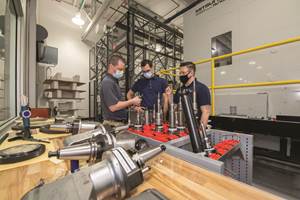Hard Turning And Cylindrical Grinding Were Made For Each Other
Combining different machining processes on the same platform has been a major theme in machine tool design for two decades or so. The Studer S242 combines cylindrical grinding and hard turning. A look at this machine shows that both of these machining processes benefit when they share the same platform.
Combining different machining processes on the same platform has been a major theme in machine tool design for two decades or so. Some of these “marriages” resulted in strained relationships in which one or both processes were compromised. Not so, it seems, with the combination of hard turning and cylindrical grinding on one machine, as indicated by the Studer S242. This machine was recently introduced by Fritz Studer AG to the world market after its initial debut in Europe at EMO 2007. (Studer AG is represented in the U.S. by United Grinding of Miamisburg, Ohio). A look at this machine shows that hard turning and cylindrical grinding seem to need each other.
The inherent rigidity of a machine designed for precision grinding is ideal for hard turning because it allows this process to deliver the roundness, concentricity and surface finish on hardened workpieces for which it is noted. The vibration-damping characteristics of a precision grinding machine prolong the life of turning tools when machining hardened materials. Likewise, turning the hardened workpiece on the same machine benefits cylindrical grinding. The part holds its original centering. No distortions or uneven stock conditions will be introduced by an intervening heat-treating step, so grinding is more predictable. The consistency of hard-turning results allows the grinding cycle time to be reduced when the same turned surfaces are subsequently ground.
Of course, all of the productivity advantages of finishing a part in one setup also apply to a combined hard turning/cylindrical grinding machine.
However, according to the builder, the S242 was designed from the ground up to support both processes. For example, the Granitan epoxy- granite machine bed is slanted to promote the free fall of turning chips and has cast-in channels for the necessary chip conveyor.
The machine’s cross slides are arranged in parallel so that the modular grinding heads and turrets can be configured as desired. The modular units include four styles of OD heads (left or right, straight or angled), two styles of tooling turrets and an ID grinding turret that can have as many as three spindles. The machine can be configured with two cross slides (10 different combinations of heads and/or turrets) or with three cross slides (15 different combinations). See the box for other key specifications.
with two slides with three slides
Distance between centers 400/1,000 mm 800 mm
Machinable length 400/800 mm 600 mm
Swing diameter 185 mm 185 mm
Maximum workpiece weight 60 kg 60 kg
Grinding wheel size 500 x 50 (63 with F5) mm 400 x 50 (63 with F5) mm
The tool turret (available with 8 or 12 positions) is not limited to turning tools. All 8 or 12 positions can be powered for milling, drilling or other operations.
Customers in Europe are already providing some interesting applications for this type of machine. In one case, the user had been machining armatures for electric motors on six conventional machines—a lathe for thread cutting, another for turning the collector packets and laminate cores and four different grinders to do four ODs on the shaft. Now, the armatures are completed on an S242 in one setup by one operator. Moving to a single clamping has also reduced runout on the shafts and armatures, resulting in quieter, cooler-running electric motors.
Related Content
Modern Bar Feeds Bring New Life to Automatic Swiss Lathes
Cam-actuated Swiss lathes are still the fastest way to process many parts. By adding modern bar feeders, this shop has dramatically improved their utilization with the ability to work unattended, even in a lights-out environment.
Read MoreDigital Twins Give CNC Machining a Head Start
Model-based manufacturing and the digital thread enable Sikorsky to reduce lead times by machining helicopter components before designs are finalized.
Read MoreInside the Premium Machine Shop Making Fasteners
AMPG can’t help but take risks — its management doesn’t know how to run machines. But these risks have enabled it to become a runaway success in its market.
Read MoreBuying a Lathe: The Basics
Lathes represent some of the oldest machining technology, but it’s still helpful to remember the basics when considering the purchase of a new turning machine.
Read MoreRead Next
3 Mistakes That Cause CNC Programs to Fail
Despite enhancements to manufacturing technology, there are still issues today that can cause programs to fail. These failures can cause lost time, scrapped parts, damaged machines and even injured operators.
Read MoreThe Cut Scene: The Finer Details of Large-Format Machining
Small details and features can have an outsized impact on large parts, such as Barbco’s collapsible utility drill head.
Read More







.jpg;maxWidth=300;quality=90)

.jpg;maxWidth=300;quality=90)


.png;maxWidth=300;quality=90)



.png;maxWidth=300;quality=90)









